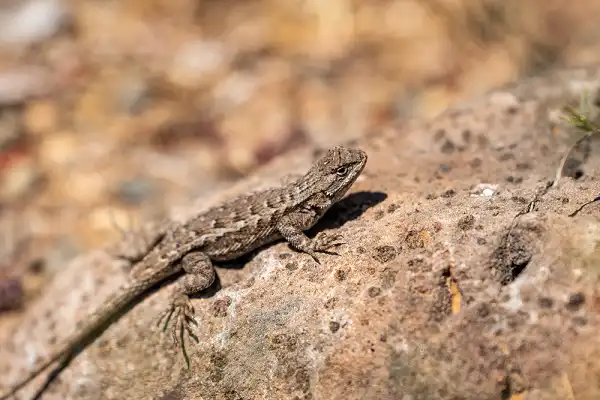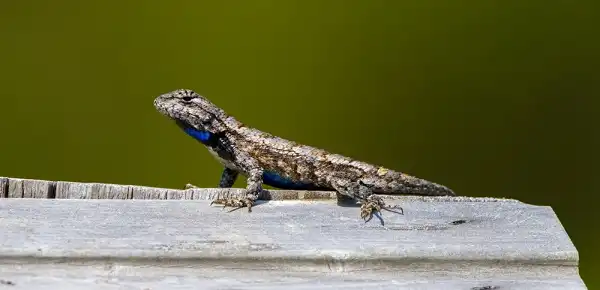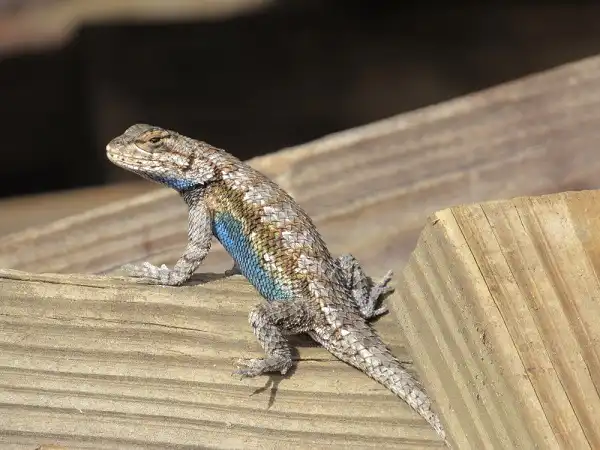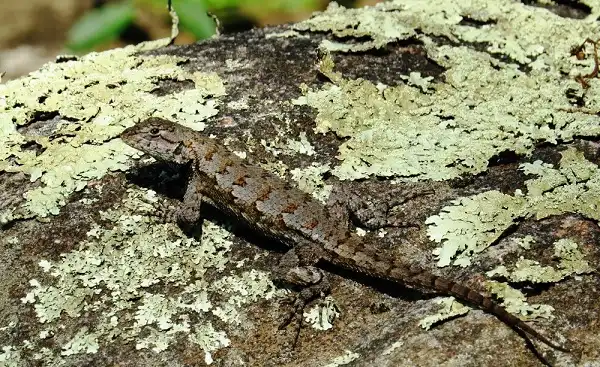Have you ever seen a small lizard perched atop an old fence post? It is likely an Eastern Fence Lizard (Sceloporus undulatus), one of the most common lizards in the United States. Be charmed by their ability to survive in various habitats, delight at their colorful designs and diversity, and learn how they have turned lizard-watching into a celebrated hobby! These little animals live throughout much of America and symbolize an appreciation for nature’s beauty. Whether they are scurrying across disturbed sites or providing much joy to experienced herpetologists, these unique reptiles appear on our radar as a fascinating group with plenty of stories to tell. Join us as we explore this incredible species!

Eastern Fence Lizard Description
The Eastern Fence Lizard is a small-sized lizard. It typically has a brown or grayish-colored body with a lighter-colored underside and may feature distinctive patterns of black spots and bands. Besides its coloration, the Eastern Fence Lizard also has a row of spines from its neck to its tail that help set it apart from other lizards. Males have bright blue patches on their bellies during the breeding season, which helps them attract mates and stand out among others of the same species. These lizards are incredibly versatile and can survive in many different habitats.
Eastern Fence Lizard Habitat
The Eastern Fence Lizard can be found in a variety of habitats, ranging from forests and woodlands to suburban gardens and even urban areas. They prefer warm climates with abundant sunshine and access to basking spots such as rocks or logs. During the colder months in northern parts of their range, they may go underneath leaf litter or into small crevices in search of shelter from the cold. They are most commonly seen on stumps, logs, outcroppings, stone walls, or fences where they can bask in the sun or hide from predators. The presence of trees provides a canopy for shade and protection as well as food sources such as insects that can be found in the bark or branches. In urban settings, these lizards are often seen on patios, decks, balconies, and other structures that provide a suitable environment for their needs. Aside from providing food resources and shelter for Eastern Fence Lizards, wooded areas also act as corridors for them to travel between different habitats.
Eastern Fence Lizard Diet
The Eastern Fence Lizard is an opportunistic feeder that primarily feeds on small arthropods such as spiders, beetles, grasshoppers, and ants. They also have been known to consume other invertebrates such as worms, slugs, snails, and caterpillars. Additionally, they may eat some plant matter such as berries and seeds, especially during times of food scarcity. These lizards actively hunt for prey in their natural habitat and can be seen scurrying across the ground in search of food or perched on logs or branches. They are able to detect the presence of prey through visual cues or chemical signals detected by their vomeronasal organ located near their nose.
Once a potential meal has been identified, the Eastern Fence Lizard will use its long tongue to grab the prey and bring it back to its mouth. The Eastern Fence Lizard is an important part of its environment’s food web since its diet consists mostly of insects that could become harmful pests if left unchecked. By consuming these creatures in large quantities, they help reduce the size of bug populations and keep them from becoming too abundant. This type of predation helps maintain a healthy balance within the ecosystem while providing these lizards with a steady source of nutrition!

Eastern Fence Lizard Size
The Eastern Fence Lizard is a small-sized lizard that can range between 3-5 inches in length, with males typically being slightly larger than females. Its body is usually brown or grayish and features distinctive patterns of black spots and bands. The underside of this species is usually lighter in color than its back and may include yellow or orange patches. In addition to its regular size, males of the species also have bright blue patches on their bellies during the breeding season which helps them stand out from other members of the species. Apart from its size, the Eastern Fence Lizard is also characterized by a row of spines running down along its sides from the neck to its tail. This feature gives it a more rigid appearance compared to other lizards and helps it defend against predators. Its toes are equipped with claws that help it climb up trees or rocky surfaces while foraging for food. Its eyes are set on either side of its head allowing for a wide range of vision as well as an increased ability to detect potential predators nearby. All these physical attributes help make this species well-adapted to its environment and give it the edge over other reptiles in the area.
Eastern Fence Lizard Lifespan
The Eastern Fence Lizard has a lifespan of about 8-10 years in the wild, with some individuals reaching up to 15 years. In captivity, these lizards can live nearly double that lifespan thanks to the optimal environmental conditions and access to food provided by their caretakers. In the wild, factors such as predation from larger animals, lack of food sources, and extreme weather conditions can all contribute to reducing the lifespan of this species. The combination of these natural occurrences often leads to increased mortality rates among juveniles who are still learning how to survive in their environment. Overall, Eastern Fence Lizards have been known to be hardy creatures capable of adapting to different habitats with relative ease. Though their life can be short-lived in the wild due to various circumstances, they have become popular amongst herpetology enthusiasts who enjoy studying these interesting critters in their natural environment. With proper care and attention, people can extend the lifespan of these fascinating reptiles and ensure that they enjoy every moment they have with them!
Eastern Fence Lizard Behavior
The Eastern Fence Lizard is a solitary creature and will often inhabit a specific area or territory. Males will establish territories by marking them with secretions produced from glands located around their heads and necks. Females are also known to display territorial behavior during breeding season when they guard their nests against intruders. During non-breeding times, these lizards may shift between areas in search of food or shelter. The behavior of this species can vary greatly depending on the environment they inhabit. In wooded areas, they tend to be more active during the day when food resources are abundant and spend most of their time basking in the sun on tree branches or stumps. In urban settings, they may be spotted lurking underneath decks or balconies as well as taking advantage of artificial heat sources like outdoor grills or lightbulbs to keep warm during colder months. These reptiles can often be seen engaging in social interaction such as head bobbing and tail waving which helps them communicate better with their peers.

Eastern Fence Lizard Speed
The Eastern Fence Lizard is capable of agile movements and can quickly dash away when faced with a predator. They are able to reach speeds of up to 16 km/h, making them one of the fastest-running lizards in North America. This speed combined with their small size makes them difficult for predators to catch and allows them to escape from danger quickly. Their bodies are well adapted for rapid movements and they use their long legs and claws to move swiftly across rocks or branches in their environment in search of food or shelter. In addition to being able to run fast, Eastern Fence Lizards are also capable swimmers and can travel across water with ease. They have been observed jumping into pools or lakes when threatened by predators, using their tails as a rudder while propelling themselves through the water. They can also climb trees well, using their claws to cling onto bark as they make their way up toward safer heights. All these abilities combined together create an impressive level of agility that helps this lizard evade potential threats in its environment.
Eastern Fence Lizard Reproduction and Life Cycle
The Eastern Fence Lizard reproduces by laying eggs. Females are able to lay up to 4 clutches of eggs with two to six eggs in each clutch. The eggs are laid in a shallow burrow dug in the ground and the female will remain nearby to protect them from potential predators. After an incubation period of around 2 months, the young hatchlings emerge and begin their life cycle independently. At birth, the young lizards are already equipped with a reddish dorsal stripe and spines running along their sides. As they mature, these stripes become more distinct, eventually maturing into regular patterns of black spots and bands along their backs.
The juvenile lizards also grow quickly, reaching sexual maturity at around 18 months old when they are about 60-90 mm in length. Once mature, the Eastern Fence Lizard’s breeding season begins in springtime when males court females by displaying bright blue patches on their bellies. During this time, males will often engage in territorial disputes with rivals as they compete for mating opportunities with females. After successful mating has occurred, females lay their eggs within a few weeks’ time before returning to their regular lives of foraging and basking once again.
Eastern Fence Lizard Hunting
The Eastern Fence Lizard is an adept hunter, preying on a variety of insects and other small organisms. These lizards are known to have excellent eyesight and an acute sense of smell which they use to locate their prey within their environment. They have been observed to actively hunt by stalking their targets and snatching them up with their long, agile tongues. In addition to hunting for food, Eastern Fence Lizards also use their hunting instincts as a form of protection against predators.
When in danger, these lizards will typically crouch low on the ground in order to blend into the surroundings and remain undetected. They may also take shelter on tree limbs or rocks when sensing ready threats from larger animals such as birds of prey. Overall, Eastern Fence Lizards are skilled hunters equipped with all the necessary tools required to survive in their environment. With keen eyesight and a sense of smell, they can quickly detect potential threats nearby as well as locate food sources no matter what time of day it is. All these traits make this species an efficient hunter that plays an important role in controlling insect populations within its habitat!

Conclusion
Eastern Fence Lizards are small, agile reptiles that inhabit parts of North America. They have a wide variety of adaptations and behaviors that help them survive in their environment such as speed, agility, swimming ability, and hunting instincts. These lizards can often be seen engaging in social behavior and courtship activities during the summer months when temperatures are most suitable for building nests and laying eggs. Their impressive physical abilities combined with their strong hunting capabilities make them formidable predators against many insects within their habitat. They also provide an important source of balance to insect populations as they keep numbers in check which helps prevent any one species from becoming too aggressive or overwhelming its surroundings.
Frequently Asked Question


